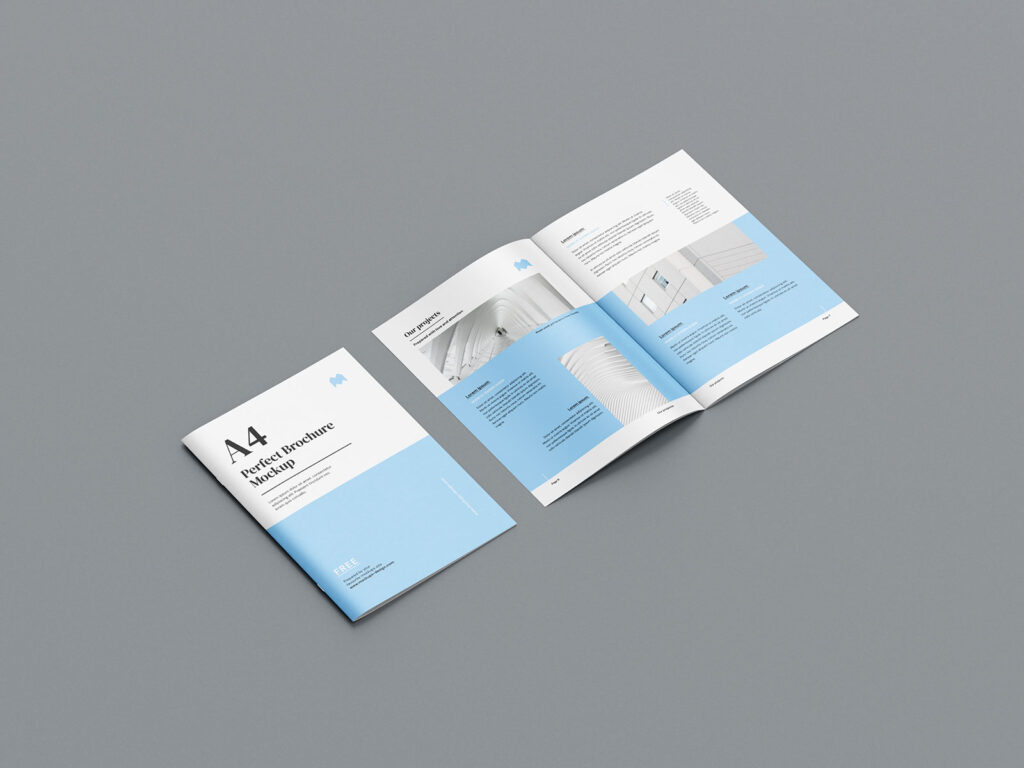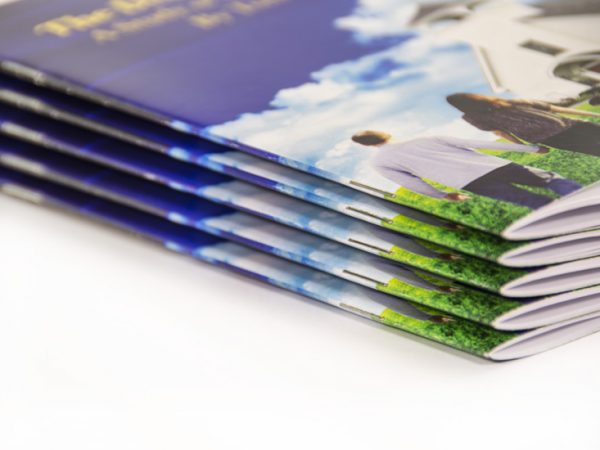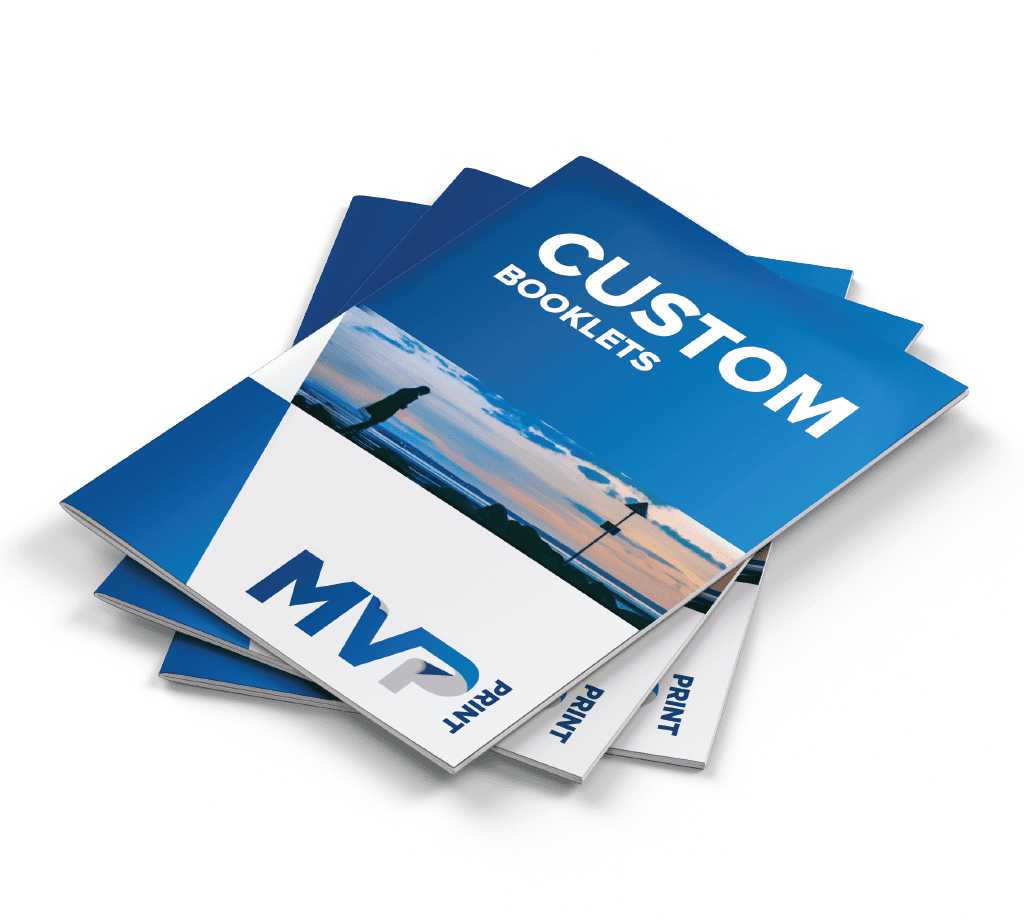
Choosing the right size and shape for your saddle stitch book is vital in ensuring it meets your specific needs and effectively showcases your content. Whether you’re creating a product catalogue an event program, or a marketing brochure, the size and shape of your saddle stitch book play a significant role in its overall impact and readability.
At MVP Print, a reputable printing company in Australia, we understand the importance of making the right choices for your saddle stitch book. Our expert team can guide you through the decision-making process, providing you with valuable advice and assistance to create a standout final product.
Understanding Saddle Stitch Book Binding Basics
Saddle stitching is a popular binding technique for booklets, brochures, and other multi-page printed materials. It offers several advantages over other binding methods, making it a preferred choice for many printing projects.
Defining Saddle Stitching Technique
Saddle stitching involves folding sheets of paper in half and stapling them together along the folded crease. This creates a clean and secure binding that holds the pages of the booklet together. The name “saddle stitching” comes from the process of placing the folded sheets over a saddle-like apparatus before stapling.
Long run books are typically bound with spooled wire staples (which automatically cuts off the wire excess thread), with the individual pages (sections) add to the cover printed section in collation towers, with folded paper meeting together and bound/trimmed. Short run books use a more traditional staple method.
Double Knot stitching (2 wires per bind position) can be used but is generally unnecessary for normal sized booklet page counts.
Advantages of the Saddle Stitched Book Over Other Binding Methods
Saddle stitch bookbinding offers several advantages that make it a popular choice for many printing projects:
- Cost-effective: Saddle stitching is a cost-effective binding method, especially for short print runs. It requires minimal materials and can be efficiently produced.
- Allows the book to open flat: One of the key advantages of saddle stitched booklet binding is that they can open flat, making them easier to use and read. This is particularly useful for instructional manuals, product catalogues, and event programs.
- Quick turnaround: Saddle stitching is a super quick process, making it ideal for book print projects with tight deadlines.
Common Use Cases for Saddle Stitched Booklets

Saddle stitch booklets are suitable for a wide range of applications. Some common use cases include:
- Event programs: Saddle stitch booklets are often used for event programs, providing attendees with a compact yet informative guide to the event.
- Product catalogues: Saddle stitch binding is an excellent choice for product catalogues, allowing businesses to showcase their offerings in a professional and organized manner.
- Instruction manuals: The ease of use and page lay-flat feature make saddle stitch booklets ideal for instruction manuals, providing users with easy access to important information.
- Marketing brochures: Saddle stitch binding is frequently used for marketing brochures, enabling businesses to present their products or services attractively.
Advantages of Saddle Stitched Booklets
| Advantages | Description |
|---|---|
| Cost-effective | Saddle stitching is a cost-effective printing booklets method, ideal for short print runs. |
| Flat opening | Allows saddle stitch booklets to open flat, enhancing usability and readability. |
| Quick turnaround | Saddle stitching is a relatively fast process, making it suitable for tight deadlines. |
Assessing the Purpose and Content for Your Printed Pages
When it comes to choosing the size and shape of your saddle stitch book, it’s crucial to first assess the purpose of the book and the content that you plan to include. This assessment will help you determine the appropriate size and layout for your pages, ensuring that your printed material effectively conveys your message and resonates with your target audience.
Consider the purpose of your printed pages. What goals are you trying to achieve? Are you creating a product catalog to showcase your offerings to potential customers? Or perhaps you’re designing an instruction manual to guide users through a complex process. Understanding the purpose of your printed pages will help you determine the tone, layout, and design elements that will best serve your objectives.
Next, assess the content that you plan to include in your saddle stitch book. Think about the information that needs to be communicated and the key messages that you want to convey. Are you presenting a lot of text-heavy information, or do you rely more on visuals? This assessment will help you determine the appropriate size and layout for your pages, ensuring that your content is presented in a clear, engaging, and easily digestible manner.
Additionally, take into account your target audience. Who will be reading your saddle stitch book? Consider their preferences, needs, and expectations. This will guide your decisions in terms of font size, language style, and overall design aesthetic. Tailoring your printed pages to your target audience will enhance their engagement and make your message more impactful.
By assessing the purpose of your printed pages and carefully evaluating the content you plan to include, you will be able to make informed decisions regarding the size and layout of your saddle stitch book. This thoughtful approach will ensure that your printed material effectively communicates your message, engages your target audience, and achieves your desired outcomes.
Selecting the Appropriate Page Count for Saddle Stitching
When it comes to saddle stitch booklets, the page count is a crucial aspect to consider. The number of pages affects not only the thickness of the booklet but also its ability to lay flat. To ensure the best results, it’s important to choose an appropriate page count that meets your needs and works well with the saddle stitching technique.
Minimum and Maximum Page Limits for Saddle Stitch Booklets
For saddle stitch booklets, there is a minimum and maximum page limit to keep in mind. This range ensures that the booklet remains manageable and the stitching process is effective. Generally, saddle stitch booklets should have a page count between 8 and 76 pages. This range allows for a substantial amount of content while still maintaining structural integrity.
The Importance of Multiples of Four in Page Numbers

One critical detail to remember when planning the page count for a saddle stitch booklet is that the `pp’ number (pp stands for printed pages) must be in multiples of four. Saddle stitching involves folding sheets of paper in half and stapling them along the folded crease. The multiple of four requirement ensures that the pages are properly aligned and evenly distributed.
Often to make them up to multiples of 4, clients will add blank pages. Often the best place to place blank pages s the inside front and back cover to keep aesthetics.
| Page CountAppropriate for Saddle Stitching | |
|---|---|
| 4 pages | ✓ |
| 8 pages | ✓ |
| 12 pages | ✓ |
| 16 pages | ✓ |
| 20 pages | ✓ |
| 24 pages | ✓ |
| 28 pages | ✓ |
| 32 pages | ✓ |
| 36 pages | ✓ |
| 40 pages | ✓ |
| 44 pages | ✓ |
| 48 pages | ✓ |
| 52 pages | ✓ |
| 56 pages | ✓ |
| 60 pages | ✓ |
| 64 pages | ✓ |
| 68 pages | ✓ |
| 72 pages | ✓ |
| 76 pages | ✓ |
Evaluating Paper Stock and Cover Options
When it comes to creating a saddle stitch book, choosing the right paper stock and cover options is essential for achieving the desired look and feel. The weight and texture of the paper play a significant role in the overall quality and aesthetics of the book.
Weight and Texture Considerations for Printing
Weight and texture are key factors to consider when selecting paper stock for your saddle stitch book. The weight of the paper refers to its thickness, which can range from lightweight to heavyweight. The texture refers to the surface finish of the paper, such as smooth, matte, or textured.
For lightweight and slim saddle stitch books, opting for a lighter weight paper is suitable. It ensures that the book remains manageable and easy to handle. On the other hand, if you’re looking to create a more substantial and substantial book, choosing a heavier weight paper will provide durability and a luxurious feel.
Texture also contributes to the overall look and feel of the book. A smooth finish offers a sleek and polished appearance, perfect for professional materials. However, if you want to add visual interest and a tactile element to your book, choosing a textured paper can create a unique and sophisticated feel.
Deciding Between Self Cover and Hard Cover Options
Another consideration when evaluating cover options for your saddle stitch book is whether to opt for a self cover or a hard cover. A self cover means that the cover is made from the same paper stock as the interior pages. This option creates a seamless and cohesive look, where the cover blends in with the rest of the book.
On the other hand, a hard cover option involves using a thicker and more rigid material for the cover. This option provides added durability and protection for your saddle stitch book, making it ideal for books that will be frequently handled or require extra sturdiness.
The choice between self cover and hard cover ultimately depends on the desired aesthetic and functionality of your saddle stitch book.
| Advantages | Considerations | |
|---|---|---|
| Self Cover | – Seamless and cohesive look – Economical option | – May be less durable – Limited design possibilities for the cover |
| Hard Cover | – Increased durability and protection – Enhanced design possibilities for the cover | – Adds weight and thickness to the book – Higher production costs |
By carefully evaluating paper stock and cover options, you can create a saddle stitch book that not only looks visually appealing but also meets your functional and aesthetic requirements.
Design Elements: Ensuring Visual Appeal and Readability
When it comes to designing saddle stitch books, there are several key elements to consider in order to achieve visual appeal and enhance readability. These design elements play a crucial role in creating a visually engaging and well-structured book that captivates readers. Whether you are designing a promotional booklet, a product catalogue, or an instruction manual, paying attention to these factors will help you create a professional and impactful end product.
Typography
The choice of typography greatly influences the overall look and feel of your saddle stitch book. Consider using legible fonts that are appropriate for the content and target audience. Pay attention to font sizes, line spacing, and paragraph alignment to ensure easy reading.
Color Scheme
A thoughtfully chosen color scheme can significantly enhance the visual appeal of your saddle stitch book. Consider using a cohesive color palette that complements your brand or message. Experiment with contrasting colors to create visual interest and ensure readability.
Layout
The layout of your saddle stitch book plays a pivotal role in its readability. Strive for a clean and organized layout that guides the reader’s eye smoothly from one page to another. Utilize consistent margins, alignment, and spacing to create a balanced and aesthetically pleasing design.
Imagery
Incorporating high-quality and relevant imagery can greatly enhance the visual impact of your saddle stitch book. Whether it’s product photos, illustrations, or infographics, choose visuals that complement the content and engage the reader. Ensure that the images are of sufficient resolution and properly placed within the layout.
By considering these design elements for your saddle stitch book, you can create a visually appealing and readable piece that effectively communicates your message and captivates your audience.
| Design Elements | Importance |
|---|---|
| Typography | Ensures easy reading and comprehension |
| Color Scheme | Enhances visual appeal and reinforces branding |
| Layout | Guides the reader and creates a cohesive design |
| Imagery | Engages readers and supports the content |
Navigating Printing and Setup Costs for Your Booklet

When it comes to printing your saddle stitch booklet, understanding the associated costs is essential for effective budget planning. The printing and setup costs can vary depending on several factors, including the size of your booklet, the number of pages, and the printing company you choose.
Kick starting Your Design with MVP Print
If you’re looking for a reliable printing company that offers design services, MVP Print is here to help. Their team of experts can assist you in kick starting your design process, ensuring that your saddle stitch booklet is visually appealing and tailored to your specific needs.
Cost-Effective Strategies for Saddle Stitch Book Printing
In addition to design services, MVP Print also provides and extensive range and cost-effective strategies for saddle stitch book printing. By working closely with their experienced team, you can effectively manage your printing costs without compromising on quality. They can offer valuable advice on paper stock options, printing techniques, and other factors that can help you stay within your budget.
Maximizing Functionality: Size and Shape for User Engagement
When it comes to saddle stitch books, size and shape play a crucial role in maximizing functionality and user engagement. It’s not just about visual appeal; it’s about creating a comfortable reading experience that encourages readers to interact with the book.
Consider how the book will be used and how it will be held and flipped through by readers. The size of the book should be chosen with user engagement in mind. It should be large enough to showcase the content effectively but not so big that it becomes unwieldy or difficult to handle.
The shape of the book also contributes to user engagement. A book with rounded corners, for example, can be more comfortable to hold and flip through compared to a book with sharp corners.
Think about the overall user experience when selecting the size and shape of your saddle stitch book. Choose a size that fits comfortably in the reader’s hands and allows for easy flipping of pages. Consider a shape that not only looks visually appealing but also feels comfortable and natural to handle.
By selecting the right size and shape for your saddle stitch book, you can enhance user engagement and create a book that is not only visually appealing but also practical and inviting to read.
Preparation and Submission of Your Design Files to MVP Print
Print-Ready File Requirements
Before sending your design files to MVP Print for printing, it is crucial to ensure that the files are print-ready. Meeting the specific file requirements will help you achieve optimal results for your saddle stitch book. Here are some key considerations:
- Format: Save your files in a format that is compatible with printing, such as PDF, TIFF, or EPS. These file formats preserve the quality of your design elements and ensure accurate reproduction.
- Resolution: Set the resolution of your design files to at least 300 DPI (dots per inch) to ensure high-quality printing. This will result in sharp and crisp images and text.
- Embed Fonts: Make sure to embed all the fonts used in your design. This ensures that the fonts will appear correctly when your book is printed, even if the recipient doesn’t have the specific fonts installed on their computer.
- Color Mode: Set your design files to the appropriate color mode for printing. For most saddle stitch books, the recommended color mode is CMYK (Cyan, Magenta, Yellow, and Black). This ensures accurate color representation in the printed version of your book.
- Bleed and Trim: Include a bleed area of at least 0.125 inches around your design to account for any slight variations during the trimming process. This ensures that there are no white borders or unfinished edges in the final printed product.
Working with MVP Print for Optimal Results
MVP Print is dedicated to helping you achieve the best possible results for your saddle stitch book. Their team of experts is available to guide you through the printing process and ensure that your design files meet the necessary requirements. Here are some benefits of working with MVP Print:
- Expert Advice: The experienced professionals at MVP Print can provide valuable advice on design considerations, paper selection, and finishing options to enhance the overall quality and appeal of your book.
- Attention to Detail: MVP Print pays close attention to every detail of your project, from file preparation to the final print. They understand the importance of delivering a high-quality end product that exceeds your expectations.
- Efficient Workflow: By collaborating with MVP Print, you can benefit from their streamlined workflow and efficient printing processes. This helps ensure that your saddle stitch books are printed and delivered within the desired timeframe.
- Quality Assurance: MVP Print has strict quality control measures in place to ensure that each printed book meets the highest standards of quality. They meticulously review the design files, conduct color checks, and perform thorough inspections at every stage of the printing process.
- Customer Satisfaction: MVP Print values customer satisfaction above all else. They strive to build long-term relationships with their clients by providing exceptional service, meeting deadlines, and consistently delivering outstanding results.
| Print-Ready File RequirementsWorking with MVP Print for Optimal Results | |
|---|---|
| 1. Format: PDF, TIFF, or EPS | 1. Expert Advice |
| 2. Resolution: At least 300 DPI | 2. Attention to Detail |
| 3. Embed Fonts | 3. Efficient Workflow |
| 4. Color Mode: CMYK | 4. Quality Assurance |
| 5. Bleed and Trim: 0.125 inches | 5. Customer Satisfaction |
Opting for Professional Finishing Touches
When it comes to creating a standout saddle stitch book, professional finishing touches can make all the difference. These additional options elevate the visual appeal and add a touch of sophistication to your book. Consider the following options for giving your saddle stitch book a polished and professional finish:
- Spot UV Coating: This technique involves applying a glossy and raised coating to specific areas of your book, creating a contrast between matte and shiny finishes. Spot UV coating can draw attention to important elements or add a subtle texture.
- Foil Stamping: Foil stamping uses metallic or colored foils to add a luxurious and eye-catching effect to your book. This technique is perfect for adding titles, logos, or decorative elements that shimmer and catch the light.
- Embossing: Embossing creates a raised three-dimensional effect by pressing the paper to create texture and depth. This technique adds a tactile element to your book and makes it visually engaging.
- Die-Cutting: Die-cutting allows you to create custom shapes, windows, or unique cutouts in your saddle stitch book. This technique offers endless possibilities for creative and attention-grabbing designs.
By choosing one or more of these professional finishing touches, you can ensure your saddle stitch book stands out from the rest and leaves a lasting impression on your readers.
| Finishing Option | Description |
|---|---|
| Spot UV Coating | Glossy and raised coating applied to specific areas for contrast and texture. |
| Foil Stamping | Uses metallic or colored foils for a luxurious and eye-catching effect. |
| Embossing | Creates a raised three-dimensional effect for a tactile and visually appealing finish. |
| Die-Cutting | Allows for custom shapes, windows, or cutouts to create unique and attention-grabbing designs. |
Conclusion
Choosing the right size and shape for your saddle stitch book plays a crucial role in ensuring that it effectively showcases your content and meets your needs. By considering the purpose of the book, assessing the content and design elements, and working with a reputable printing company like MVP Print, you can achieve high-quality printing and a successful end product.
Take the time to plan and prepare your design files, following the print-ready file requirements, to ensure optimal results. Additionally, don’t overlook the opportunity to enhance your saddle stitch book with professional finishing touches like spot UV coating, foil stamping, embossing, or die-cutting. These extra touches can add a touch of professionalism and make your book stand out.
By following these steps and working with the experts at MVP Print, you can create a saddle stitch book that leaves a lasting impression. It’s the perfect combination of the right size and shape, high-quality printing, and attention to detail that will make your saddle stitch book truly shine.








